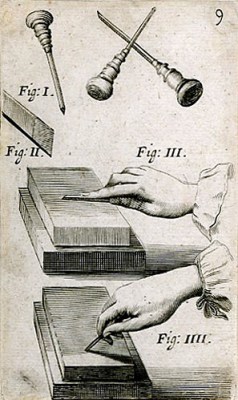 The upper part of this figure will ſhew two ſorts of Graving-tools, the one formed ſquare, the other lozeng: the ſquare Graver makes a broad and ſhallow ſtroak, or hatch; and the lozeng makes a deep and narrower ſtroke. The uſe of the ſquare Graver is to make the largeſt ſtrokes, and the uſe of the other is to make the ſtrokes more delicate and lively. But I preferre a Graver made of an indifferent ſize betwixt both theſe two; which will make your ſtrokes, or hatches, ſhow with more life and vigour; and yet with ſufficient force, according as you ſhall manage it in your working: The forms of which will appear in the I. and II. figures.
The upper part of this figure will ſhew two ſorts of Graving-tools, the one formed ſquare, the other lozeng: the ſquare Graver makes a broad and ſhallow ſtroak, or hatch; and the lozeng makes a deep and narrower ſtroke. The uſe of the ſquare Graver is to make the largeſt ſtrokes, and the uſe of the other is to make the ſtrokes more delicate and lively. But I preferre a Graver made of an indifferent ſize betwixt both theſe two; which will make your ſtrokes, or hatches, ſhow with more life and vigour; and yet with ſufficient force, according as you ſhall manage it in your working: The forms of which will appear in the I. and II. figures.
The III. figure ſhews you how to whet the two ſides of your Graver, which is to be done in this manner following; you muſt have a very good oyl-ſtone ſmooth and flat, and having powred a little Sallad oyl thereupon, take the Graver, and laying one ſide of it (that which you intend ſhall cut the copper) flat upon the ſtone, whet that ſide very flat and even; and to that purpoſe have an eſpecial care to carry your hand ſtedfaſt, and with equall ſtrength, placing your forefinger very firm upon the oppoſite ſide of your Graver; to the end that you may guide it with the more exactneſſ: then turn the very next ſide of your Graver, and whet that in the like manner, as you did the other; ſo that there may be a very ſharp edge for the ſpace of an inch or better; then turning uppermoſt that edge which you have ſo whetted, and ſetting the end of your Graver obliquely upon the ſtone, carry your hand exactly even, to the end that it may be whetted very flat and ſloping, in the form of a lozeng, making to the edge a ſharp point, as the figure IIII. ſhews you.
It is very neceſſary that you take great care in the exact whetting of your Graver; for it is impoſſible that you ſhould ever work with that neatneſſe and curioſity as you deſire, if your Graver be not very good, and rightly whetted.
I cannot demonſtrate it ſo plain and fully by figures, and diſcourſe, as I would: if you have acquaintance with an Artiſt in this way, you may eaſily underſtand it in a ſhort time.
William Faithorne
The Art of Graveing and Etching – 1662
—Jeff Burks